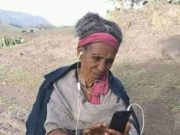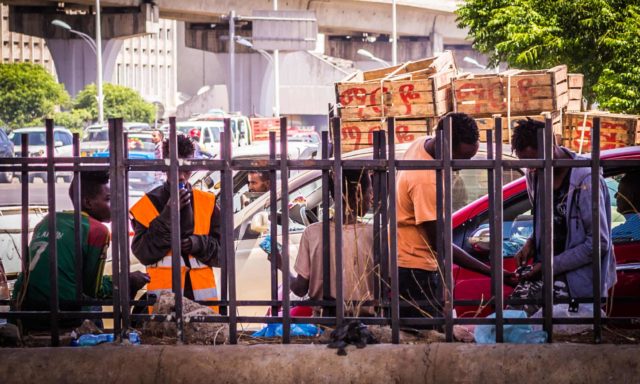Driven from their rural homes by family problems and lack of opportunity, more and more children are making for Addis Ababa. Alone and vulnerable, they receive no state support
ehind Addis Ababa’s most iconic public space, Meskel Square, down a cobblestone alleyway in the shadow of half-finished high-rises, lies a small corner of the Ethiopian capital known by locals as “DC”.
Nestled between cramped brothels and dimly lit bars, it consists of low-slung, tin-roofed dwellings containing rows of bunk beds. Each night, hundreds of homeless children come looking for a place to sleep, sometimes two to a mattress.
One house, run by 27-year-old Mabit and her family of six, hosts about two dozen children a night. She charges them 20 birr (50p) each, and cooks food to sell to them. The dormitories are damp and crowded, and some of the boys can be drunk and violent, but it’s better than a night on the street.
Street children, especially young boys, have been increasingly visible in Addis Ababa in recent years. Thousands ply their trade at the city’s traffic-choked intersections, some hawking cigarettes and chewing gum, others begging. Many clutch plastic bottles filled with glue from which they take regular sniffs.
The last official survey was conducted as far back as 2010, but even then there were an estimated 12,000 children living unaccompanied on the streets of the capital. NGOs estimate much higher figures today. Mabit, who has been renting beds to children for a decade, also reckons the numbers are rising, a view echoed by officials.
“We have a very huge problem – and it’s getting bigger and bigger,” says Hunegnaw Ayele Abate, director of social protection at the city’s bureau of labour and social affairs.
Children as young as six come to the city to escape rural drudgery and, in many cases, family breakdown. “The reason is always poverty – but poverty plus [something else],” says Lynn Kay, country director of Retrak Ethiopia, an organisation that rescues street children in Addis Ababa and reunites them with their families.
One recent survey found that almost half the street children sampled were living with step-parents because their biological parents had died, divorced or separated.
Chala, 15, from Hararghe in eastern Ethiopia, has knife scars all along his forearms. He came to Addis three years ago, after his mother died and his father started drinking, beating him and his five younger siblings. “I was the breadwinner,” he explains.
Most come from rural villages, and especially from what researchers call Ethiopia’s “southern corridor” of migrant-sending communities, where a tradition of relocation to Addis Ababa and even further afield is well established.
Sisay, 13, from the countryside surrounding the southern town of Shashamane, left for the capital two years ago with a large group of friends. “I didn’t know anything about Addis but my friends said it would be a really amazing place,” he says.

Many of his peers in the capital are from southern areas like Wolayita, districts known for sending migrants to the capital. Such areas are characterised by high population density and land fragmentation, putting extra pressure on poor households with large numbers of children. Youth unemployment in some districts can be as high as 50 %. Child traffickingnetworks, which are often responsible for bringing girls to Addis Ababa, are particularly active.
Life on the streets of the capital is unremittingly tough, even for those who earn enough each day to afford a bed in DC or similar quarters elsewhere. School is impossible without a city ID card, begging is stigmatised, and police brutality is commonplace. One charity reports that, when asked to draw a picture of life on the streets, almost all the children it works with sketch an image of a policeman. “The police treat us like we are goats,” says Bedasa, 18, a friend of Chala.
Girls usually end up in domestic service, where sexual abuse is rampant. The US state department’s 2016 Trafficking in Persons report found that girls as young as eight were working in brothels around Addis Ababa’s central market. Kay says about 80% of girls who come to Retrak report sexual abuse, though she adds that a rising number of boys are reporting it too. Many contract hepatitis B, a liver infection that can be transmitted through sex.
Charity workers say glue-sniffing has increased dramatically over the past couple of years. The substance is easy to obtain: souks sell 5ml in plastic bottles for only 10 birr and there is no age restriction. Shoeshine boys who use glue for repairing shoes say it is now too expensive because the bulk is being sold to children for sniffing. “Nobody stops them,” says Muluken Seyoum, an official in the ministry of women and children affairs.
Chala says he and his friends do it to stifle hunger and numb the cold at night. “You will forget everything for hours,” he explains. “We know it’s scary but we can’t find a way to stop the addiction.” Bedasa says it helps them cope with pain when they are beaten by police.
There are no government programmes or facilities for street children. The only help comes from a handful of small-scale charities that receive little by way of government assistance. A restrictive civil society law makes it hard for them to operate. Hold My Hand, a shelter taking care of 26 boys, depends on the support of just two US donors. “Raising children from the street is not our job,” says founder Mikiyas Fekadu. “But we are doing it because [the government] is not.”
“It’s kind of a vicious circle – we pick them up; they come back again. It’s a real headache for the government,” says Muluken.

There are hopes that the country’s new administration, led by reformistprime minister Abiy Ahmed, will pursue a different tack. This year, the ministry of women and children affairs is using the motto “Children on the streets have a right to live” – which, Kay argues, is a “quantum leap away” from its 2017 motto, “Cleaning Addis Ababa’s streets of children”. The civil society law is being revised and Fekadu says the government has started consulting with NGOs more.
Meanwhile, Hunegnaw says his bureau’s approach to rehabilitation and reintegration is changing, with more focus on education and vocational training to discourage children from returning to the streets. “We’ve learned from the previous mistakes,” he says. The bureau is also proposing the creation of a special centre offering shelter, food and sanitation. An urban safety net programme, launched in 2017 and supported by the World Bank, now helps some of the city’s most destitute, including street children, by giving them a small cash handout in exchange for work like street cleaning.
But the broader problem is more intractable. Street children are “part and parcel of the wider process of urbanisation” says Tatek – and the population of Addis Ababa alone is expected to double to more than 8 million over the next decade. Nationwide, the urbanisation rate is an estimated 4-6% a year, putting enormous pressure on municipal infrastructure and services. Despite the misery of life on the streets, the alternative – a permanent return to the countryside – is “very, very rare,” he says.
Among the street children Tatek has studied since 2005, not one has gone back permanently.
/The Guardian/
























